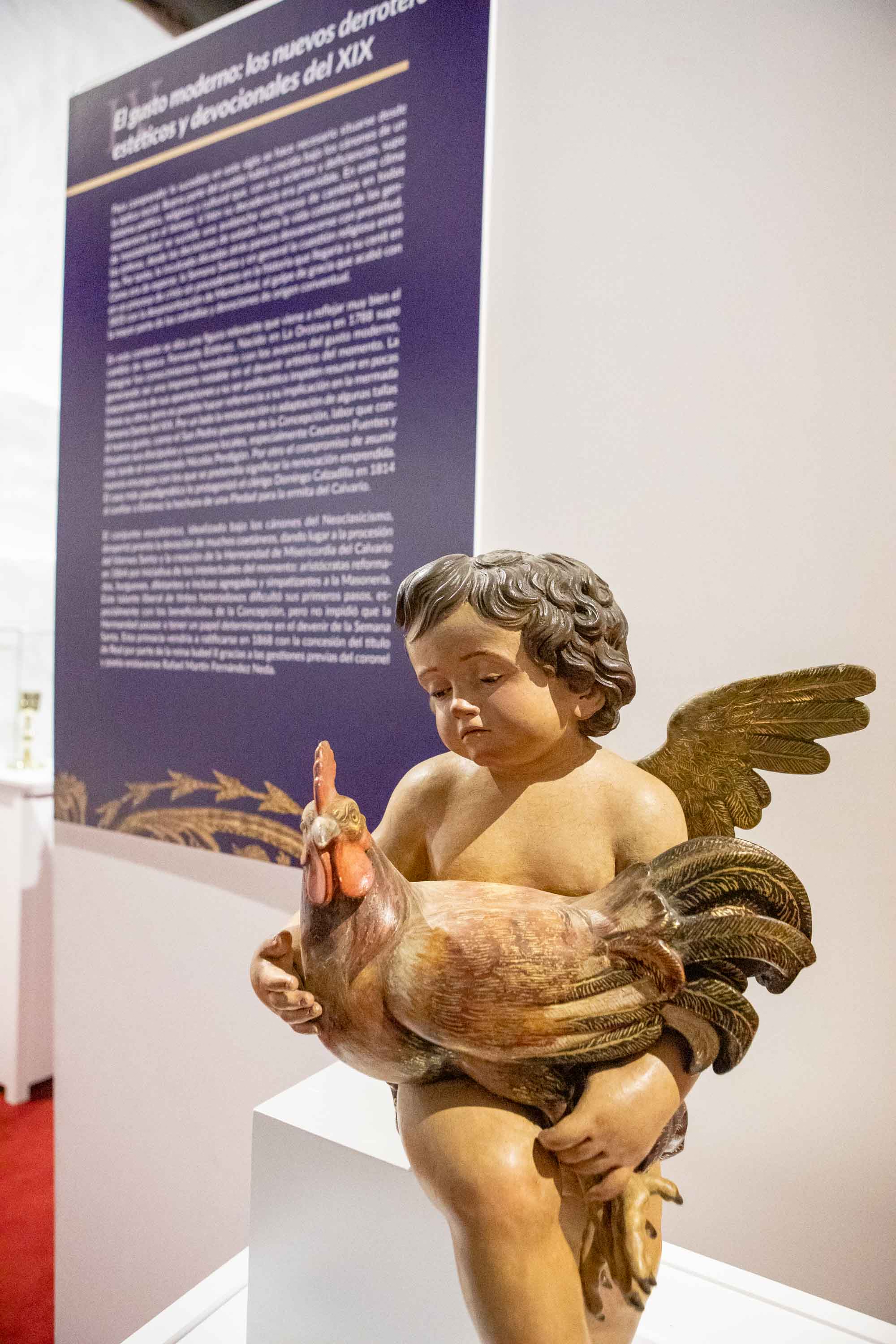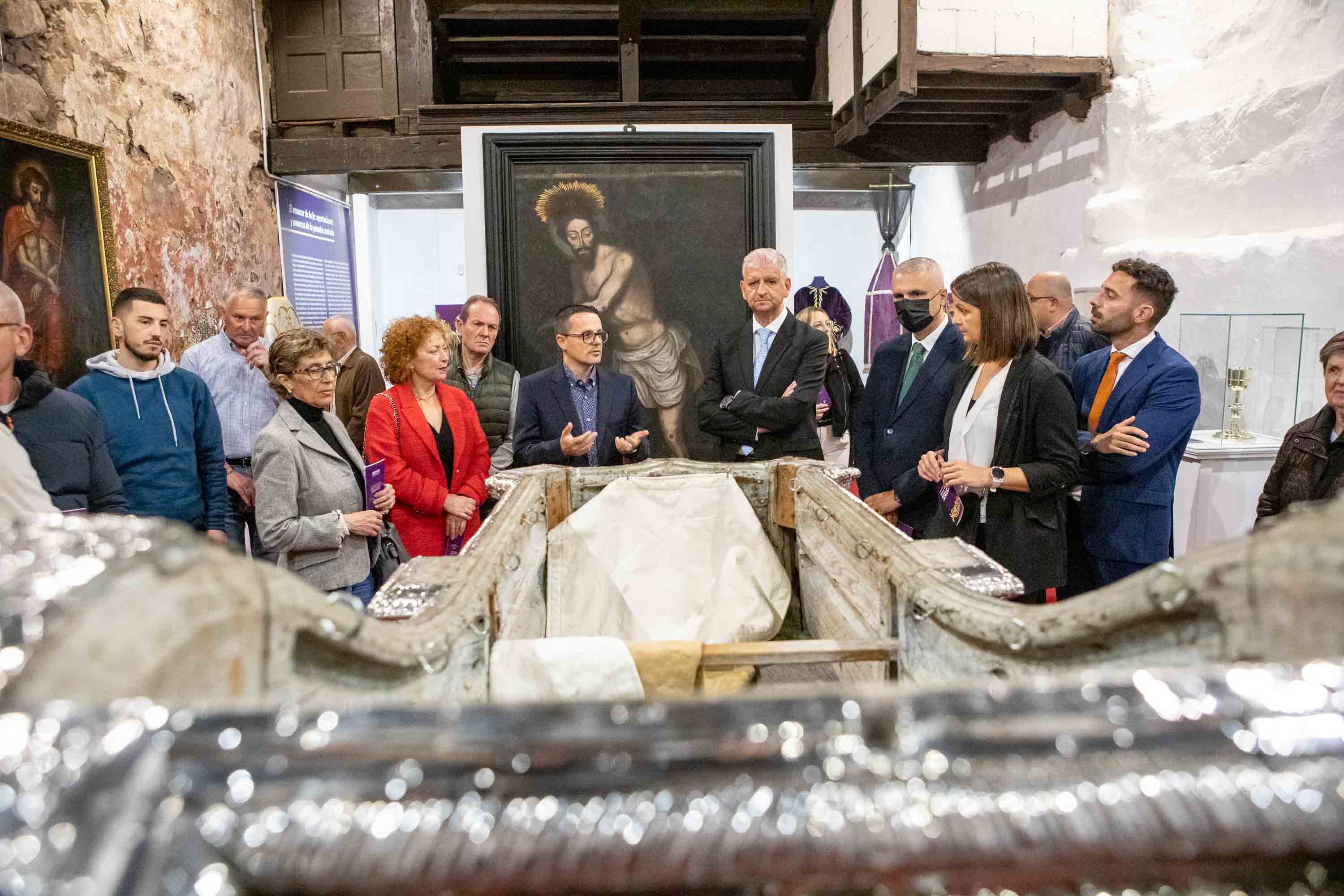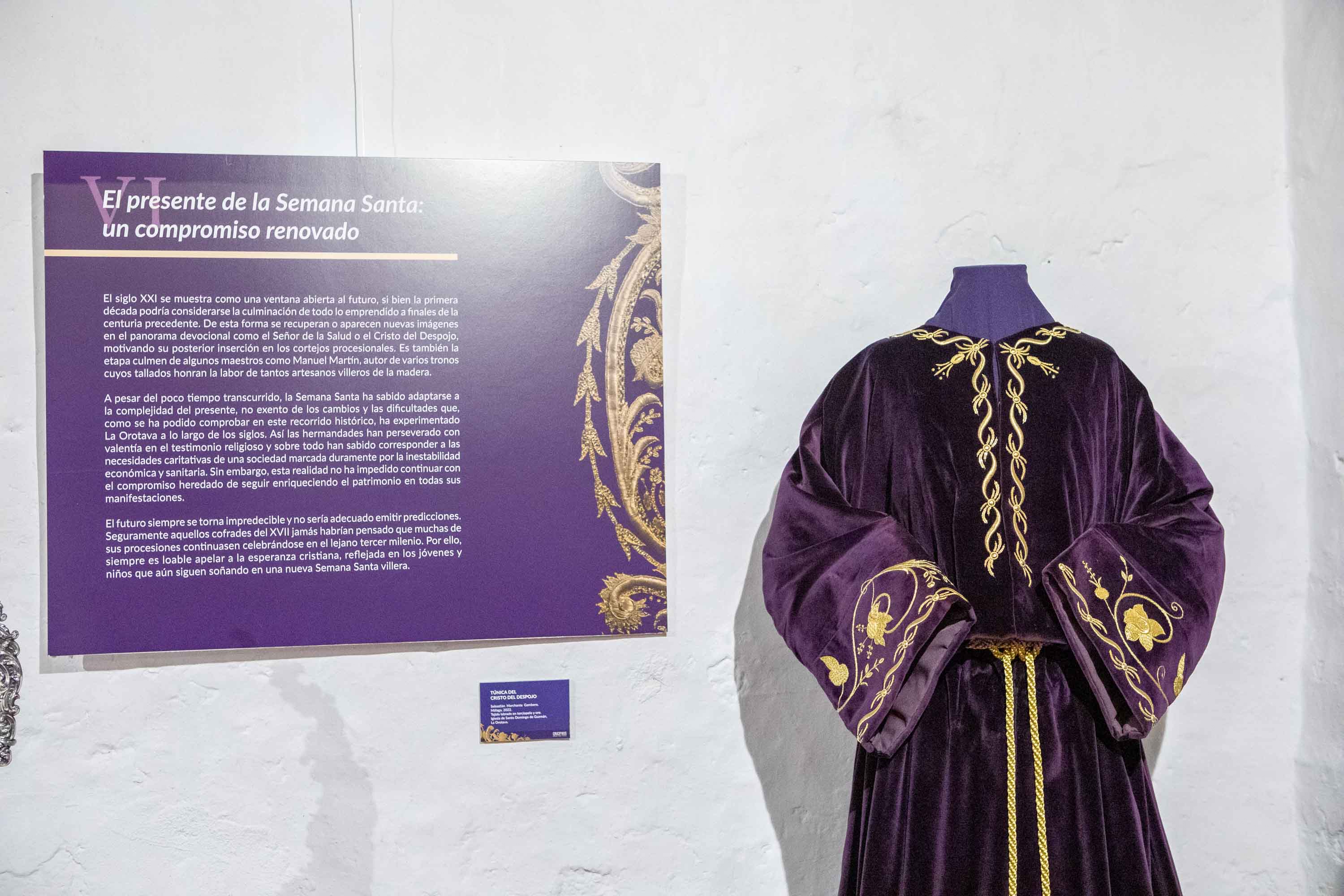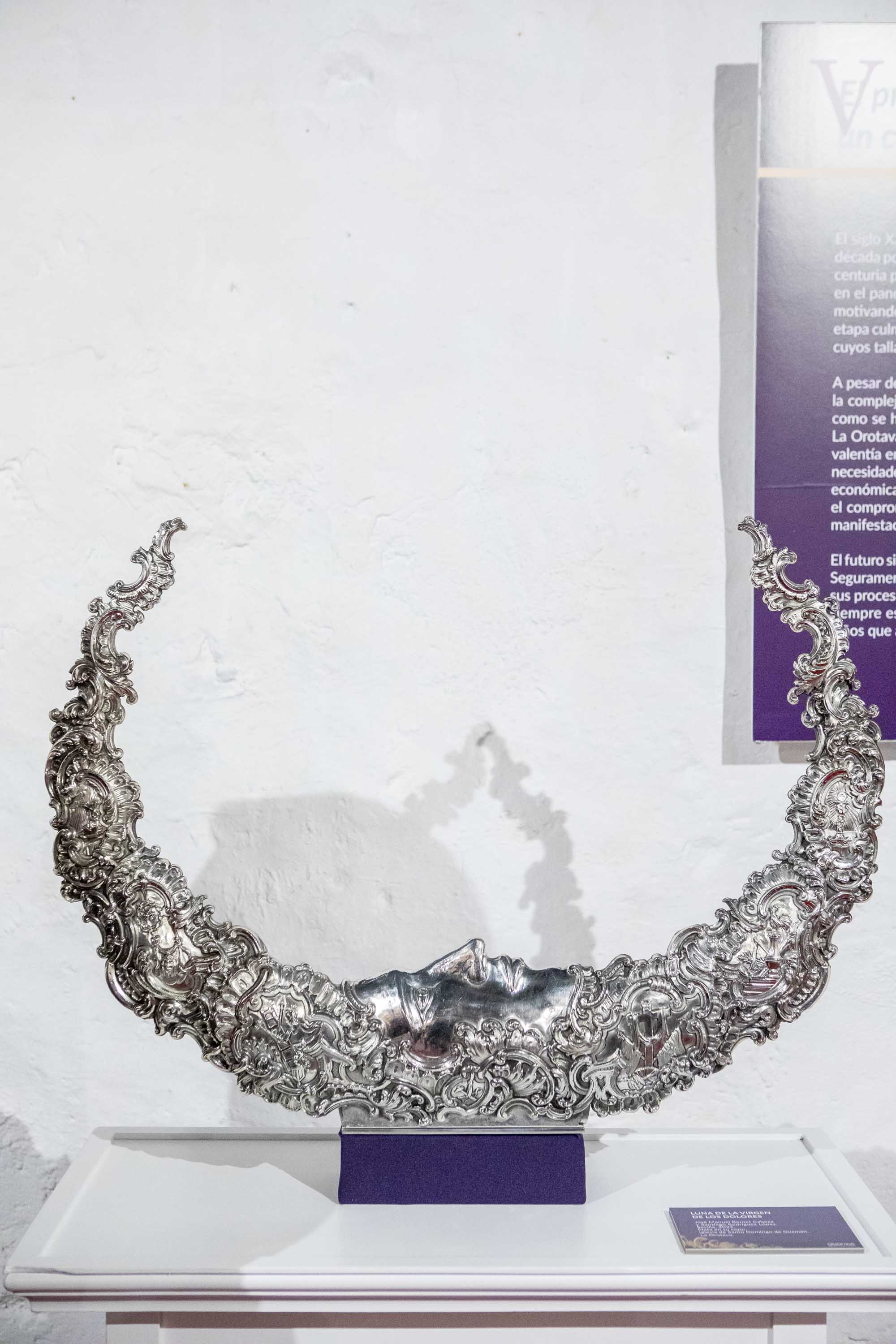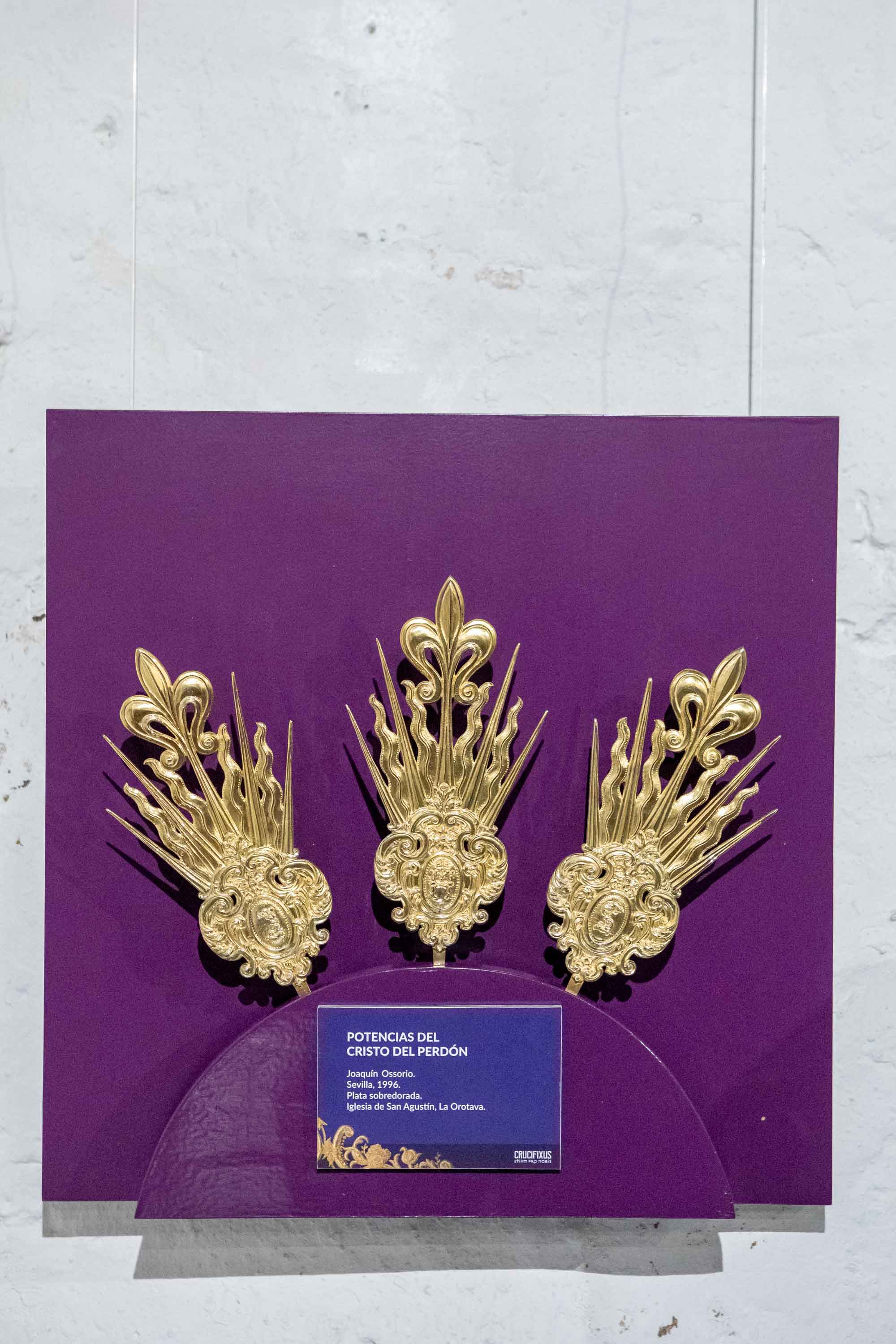
THE HOLY WEEK IN VILLA DE LA OROTAVA.
The annual commemoration of Jesus Christ’s Passion, Death and Resurrection in Villa de La Orotava represents the staging of one of the main sociocultural events in the town, which has reached a significant relevance since its origins, together with the patron saints' feasts and especially with the Corpus Christi Infra octave, when La Orotava is visited by a larger number of people. During the development of the events that constitute the La Orotava Holy week, the devotional component that underlies each act, individualized in the recollection and personal reflection of those present, acquires added value. These actions are not at odds with the contemplation of true works of art, in the form of processional floats that seize the streets during those days.
In a town characterized by its recognized and ancestral cultural tradition and important spiritual substrate, a series of patrimonial premises come together during the celebration of the Holy Week, which define it not only as one of the most important ones of the island of Tenerife, but also of those that are commemorated in any other region of Spain each year. Premises that include the magnificent stage in which it takes place as well as the streets of one of the most unique and, fortunately, most preserved Historical Sites of the archipelago. These streets become, during more than seven days, the extension of a succession of significant religious temples which guard extraordinary sculptural images of both local and foreign origin. Images that are carried in procession on artisan wooden thrones or silver portable platforms, preserved thanks to the effort and dedication of ancestral confraternities. The ‘Orotava’ Music Group and the ‘San Juan’ Horns and Drums Band accompany them with their musical interpretation in most of the processions and, together with the singing of ‘malagueñas’ (flamenco genre assimilated by the local folklore) and the Miserere on the night of Holy Thursday, generate evidence that the architectural, plastic, ethnological and anthropological aspects, merge indissolubly during the celebration of the Holy Week in Villa de La Orotava.
Within this cultural frame, a sober and elegant Holy Week is developed, devoid of decontextualized foreign customs that, gradually, have made way in the ones celebrated in other towns of the islands. La Orotava’s Holy week fortunately preserves the essence of past centuries in spite of the logical social evolution inherent in the passage of time. Very little has changed the original physiognomy of the celebration of the Passion of Christ in La Orotava, with respect to its gestation and consolidation - seventeenth and eighteenth centuries - and to its last development - nineteenth century. In this sense, traditional conditions that place it very close to the pre baroque and baroque parameters still exist, sifted by the island's spiritual temperance, both from the perspective of the imagery used in the processional floats, and from the point of view of the staging of the Liturgy.
Neither has the high degree of devotion among the people of a town marked since its origins by a deep-rooted religious culture, changed much; greatly due to the establishment of religious orders and communities that played a fundamental role in the historical development of the town. Such devotion acquires a natural character by means of an accentuated cult of images which has prevailed among the inhabitants of La Orotava since ancient times, and which perhaps remains as the only vestige of a baroque culture that marked the development of both religious imagery and people’s piety.
The popular devotion of La Orotava’s Holy Week is mainly based on Christological images that are preserved in the town. There is a splendid catalogue of carvings of great artistic interest such as ‘El Crucificado’ of the Concepción church or ‘El Nazareno de Santo Domingo’ among many others, without forgetting ‘El Cristo atado a la columna’, one of the main references of the Passion Week- both from an artistic and a devotional point of view -, which can normally be found in the Parish of San Juan Bautista. However, it should be noted that along with the fervour generated by the images of Christ among those who attend the Holy Week processions, there is also the devotion and admiration that the image of ‘La Madre Dolorosa’ or ‘Virgen de Los Dolores’ awakens among the faithful and visitors alike. This Sorrowful Virgin also assumes other iconographic roles in La Orotava, such as the one of ‘La Virgen de Gloria’, ‘La Piedad’ or ‘la Soledad’, being present in the totality of the main temples of the town’s Historical Centre.
The origin of the celebration of the Holy Week in La Orotava is clearly linked to the presence of religious orders in the town, which contributed decisively to the development of this celebration, taking into account that La Orotava came to have six convents. In this sense, we must point out that the Franciscans were the initiators of such parading of processional floats as ‘La Horación del Huerto’ or ‘El Santo Entierro’, the ‘Via Crucis’ prayer and the cult of the Sorrowful Virgins. The Augustinians, in turn, spread the tradition of Sorrowful Friday, and the Dominicans, the ‘Jesús Nazareno’ processional float parading and its popular Encounter. It should also be noted that the initial impulse of the religious orders will be, later on, taken up and consolidated by the confraternities and fraternities dedicated, among other functions, to the care and worship of the images and their processions. They will be constituted in the parishes from the earliest dates of the first processions recorded in La Orotava, dated in the 17th century.
The urban structure and the location of the temples in the Villa de La Orotava Historic Centre have generated, from its origins, a natural setting conditioned by its particular orography, which soon proved to be an excellent ally in order to manifest the spiritual and artistic effects sought by ecclesiastical authorities. The inclination of the streets and their sometimes irregular layout provide unbeatable opportunities for contemplation of the processional floats and the parade of the confraternities and other protagonists of the liturgical scenery.
This and other no less transcendental issues have shaped a special Holy Week, characterized by three main reasons that differentiate it from those celebrated in the rest of the archipelago. Firstly, the survival of the ‘porters’ who carry the thrones or bases of the images, provided with poles for this purpose, as opposed to the pallbearers or ‘costaleros’, foreign fashions that unfortunately have been imposed in other major Holy Week celebrations in the Canaries. Secondly, the absence of sculptural groups, which means that each processional float is carried on its corresponding throne, except for the three indivisible images – ‘La Oración en el Huerto’, ‘La Piedad’ or ‘El Cristo de El Calvario’ and ‘Jesús Nazareno’ - . In third and last place, we must emphasize the unitary character of the La Orotava Holy week, at least in its founding nucleus. Each temple celebrates its worship individually but synchronized with other churches, without overlapping with each other, according to a systematic schedule of predetermined dates and times. That is to say, that in La Orotava the different processional floats are not paraded in a simultaneous way but are complemented and integrated in a set. There is not a Holy Week in each parish, but only a single Passion Week.
THE MUSICAL COMPONENT OF THE HOLY WEEK IN VILLA DE LA OROTAVA.
Except for the logical exception of certain religious services, ceremonials and processions of the Holy Week in La Orotava, music has been present in its celebration, at least since the beginning of the 20th century, complemented by the percussion and winds of the San Juan Bautista Band since the 1960s.
Today the processional marches contribute to highlight the sensitive character that singles out the parading of the different floats in the streets of the Historic Centre of La Orotava, providing them with an accentuated atmosphere of solemnity. In this sense, the ‘Orotava’ Music Group, nurtured by successive generations of local musicians, masterfully interprets compositions of both national and foreign authors, with a prevailing influence of the typical musicality of Castilian and Andalusian Holy Weeks.
Nevertheless, the most popular and characteristic musical interpretations of the Holy Week in La Orotava take place on the night of Holy Thursday, with the ‘Cristo atado a la Columna’ image as the main inspiration. These are the celebrated ‘malagueñas’, flamenco genre assimilated by the local folklore that has transcended the celebration of the Passion Week, performed live since 1988 and, above all, the ‘Adiós a la Vida’ from the opera Tosca, composed by the Italian Giacomo Puccini in 1900 which permeates the extraordinary atmosphere that is generated during the entrance of the Christ and his cortege in the Town Hall Square.
Acts of the Holy Week in Villa de La Orotava:
- Friday before the Passion Sunday.
At 9:00 p.m., the celebration of the ‘Via Crucis’ from the Parish of Nuestra Señora de la Concepción to the Municipal Cemetery takes place, parading the ‘Cristo de la Buena Muerte’ image, a polychrome wood carving made by the local sculptor Ezequiel de León between 1992 and 1993, at the request of the ‘Vera Cruz y Misericordia’ confraternity, after the loss of the previous image in the fire that took place in the chapel of the cemetery in 1986.
- Saturday prior to Passion Sunday.
At 8:00 p.m., the procession of ‘Santísimo Cristo de la Salud’ takes place, through the streets closest to the church of San Juan Bautista, an image made in polychrome wood in 1998 by the sculptor Francisco Romero Zafra, from Cordoba, at the reques7t of the Machado Melián family, who donated it to the aforementioned parish.
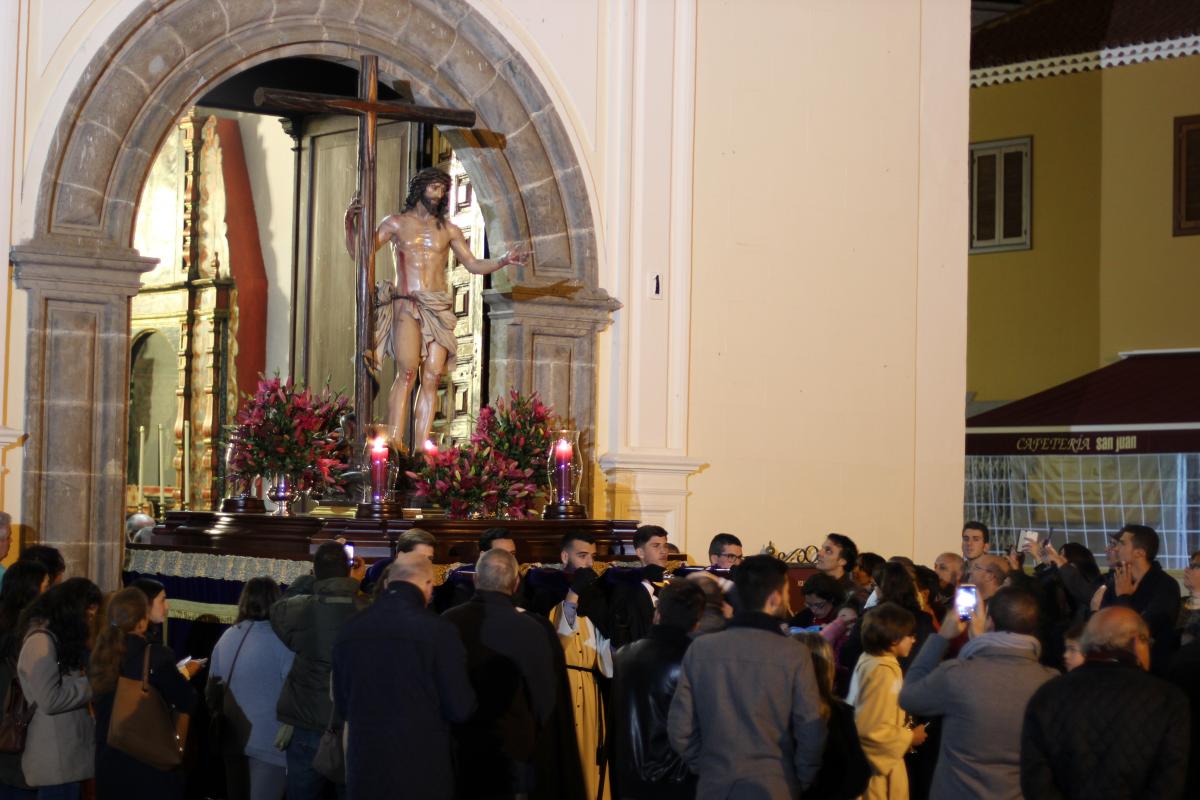
- Passion Sunday.
At 7:00 p.m., leaving from the church of San Agustín and around the Constitución square, we can see the image of Santísimo Cristo del Perdón, a polychrome wood carving from the 17th century attributed to the sculptor Gabriel de la Mata. Its previous cult is carried out, and its processional float is taken care of, by the ‘Santísimo Cristo del Perdón y Nuestra Señora de Gracia’ Fraternity and Confraternity, founded in 1991.
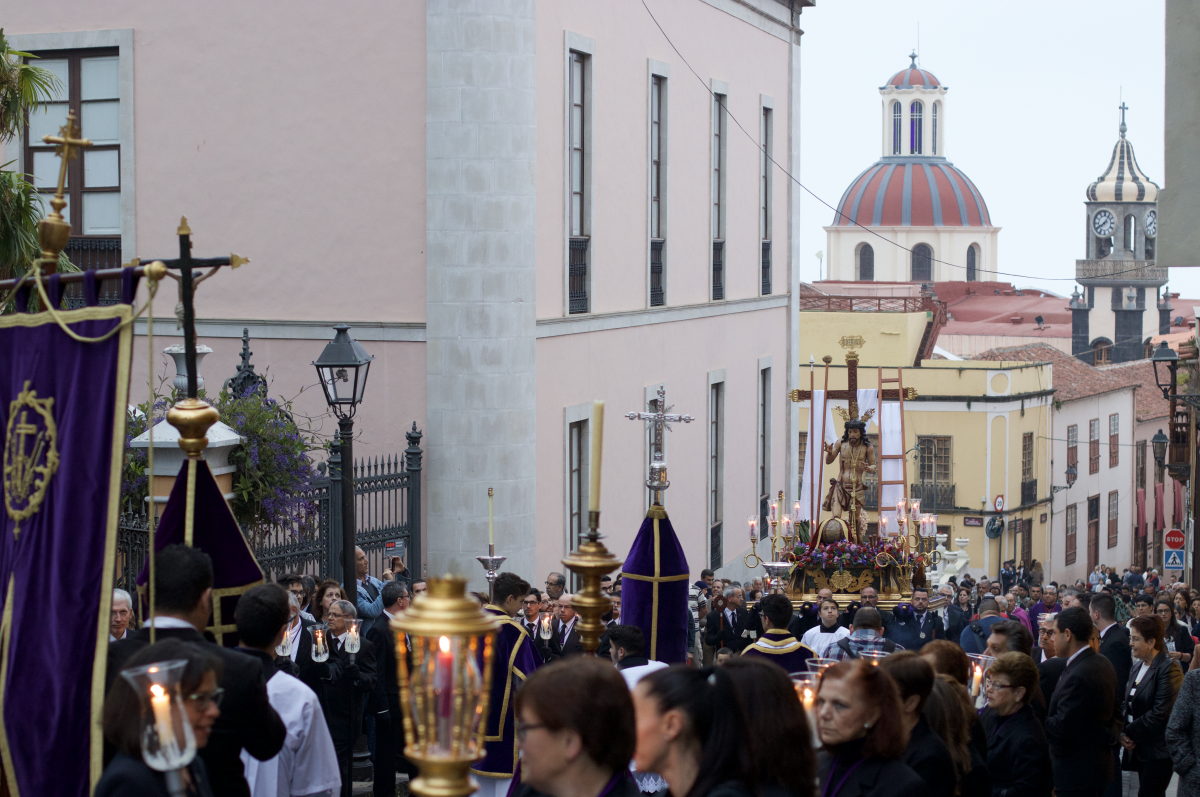
- Friday of Sorrows.
At 9:00 p.m., a procession leaves from the church of San Agustín and parades around the Constitución square, with the image of ‘Nuestra Señora de los Dolores’, anonymous image from the seventeenth century. A now disappeared Female Confraternity was in charge of its cult. In 1989 it was recovered and integrated in the ‘Santísimo Cristo de la Humildad y Paciencia’ Confraternity.
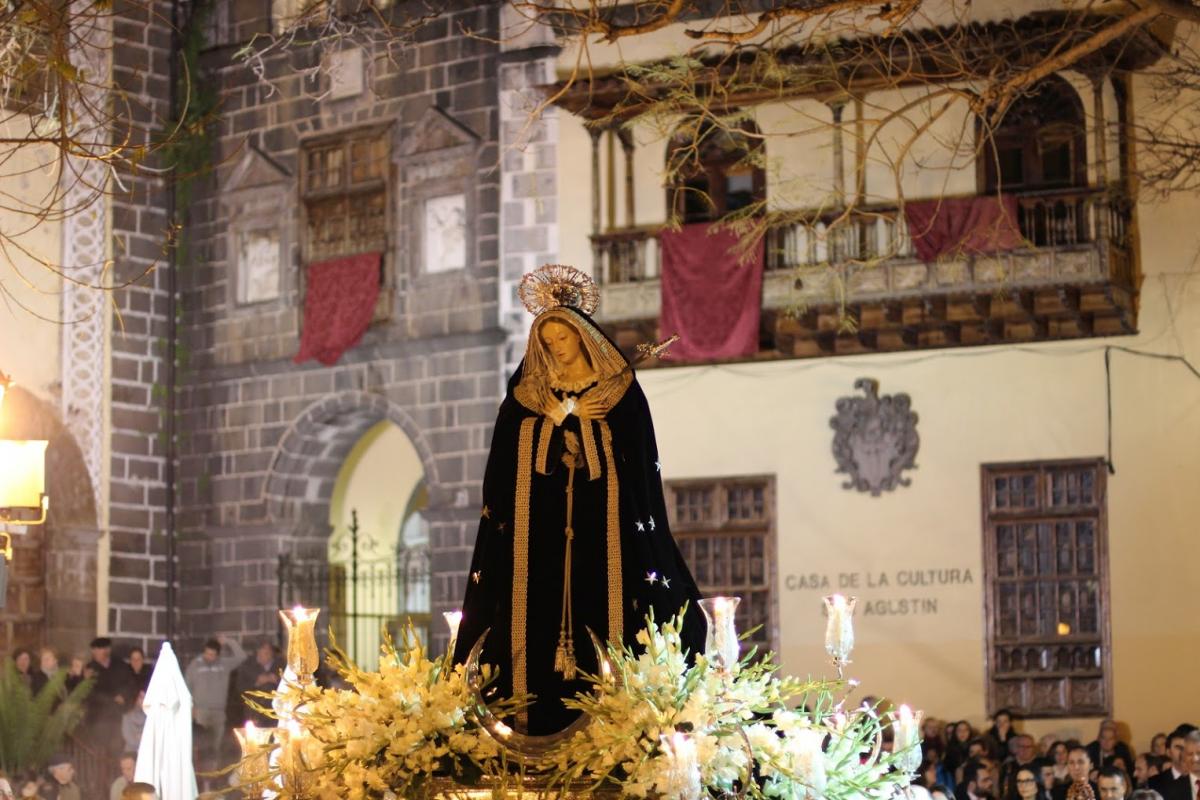
- Passion Saturday.
At 8:00 p.m., from the church of Santo Domingo de Guzmán and parading by the streets closest to the aforementioned temple, we find the procession of ‘Nuestro Padre Jesús del Despojo’, polychrome wood sculpture made in 1999 by the local sculptor Pablo Cristóbal Torres Luis. It is the processional float of more recent incorporation to Holy Week in La Orotava, counting with its own confraternity since the year 2004.
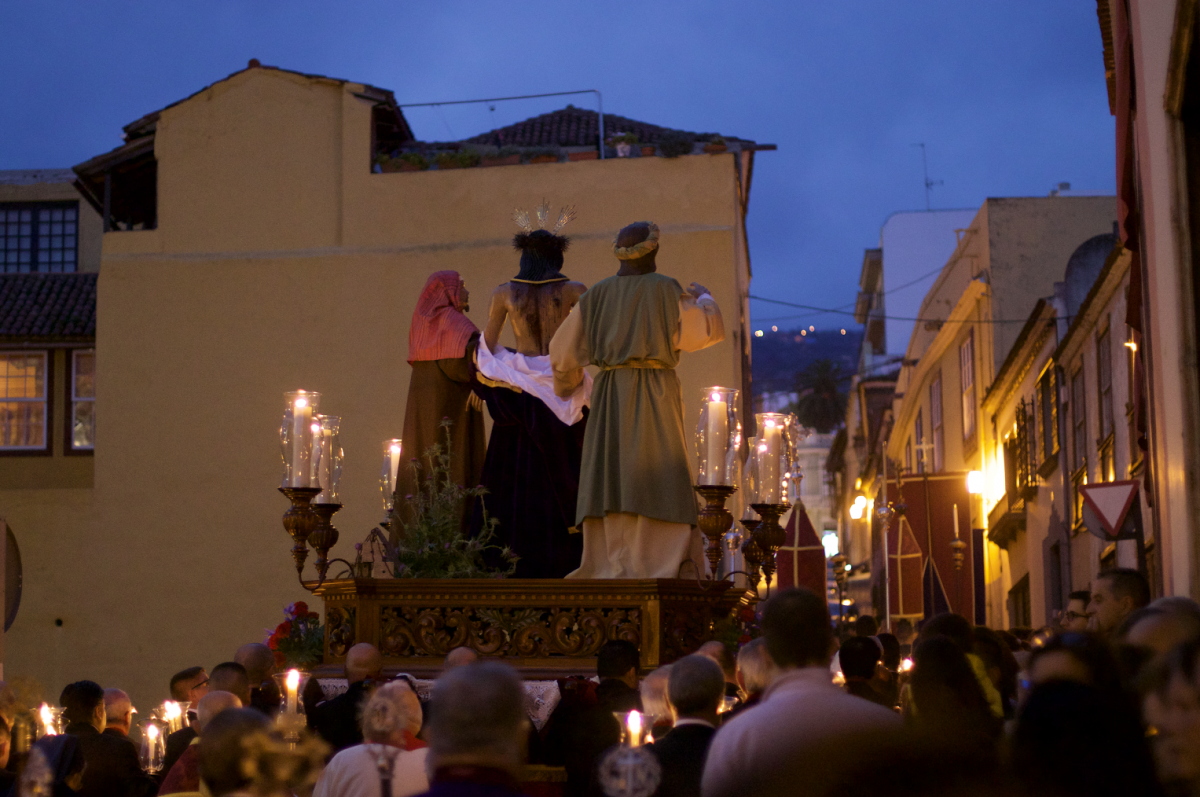
- Palm Sunday.
- Triumphal Entry of Jesus in Jerusalem.
At 10:30 a.m., leaving from the Chapel of María Auxiliadora in the San Isidro Salesian school, the Blessing of Palms and Olive Tree Branches and the subsequent procession to the Concepción church takes place. The image used is the Triumphal Entry of Jesus in Jerusalem, popularly known as ‘Señor del Burrito’ (Lord of the Little Donkey), a carved image made in 1957 in the workshops of Olot, in Gerona. The children have a major role in this procession, even counting, in the 1960s and 1970s, with a children’s confraternity under the protection of the Salesian community.
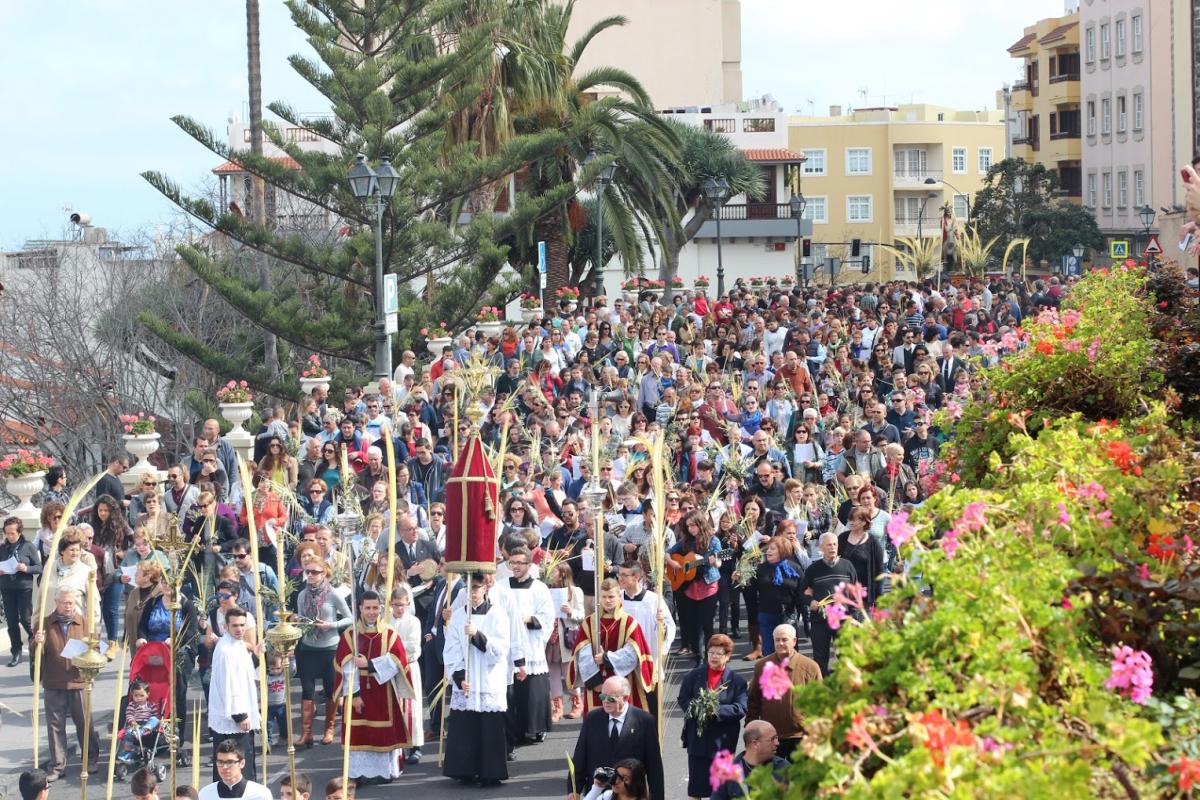
- The Preaching Lord and the Conversion of Magdalene.
At 12:30 p.m., from the church of Nuestra señora de La Concepción, the procession of the ‘Señor Predicador’ takes place; a dressed image made in 1667 and attributed to Blas García Ravelo, accompanied by the ‘Magdalena Penitente’, made by the Gran Canarian artist José Luján Pérez at the end of the 18th century. This processional float belonged to the temple of San Benito Dominican convent- now Parish of Santo Domingo de Guzmán -, becoming part of the assets of the Parish Church after the Mendizabal confiscation in 1835.
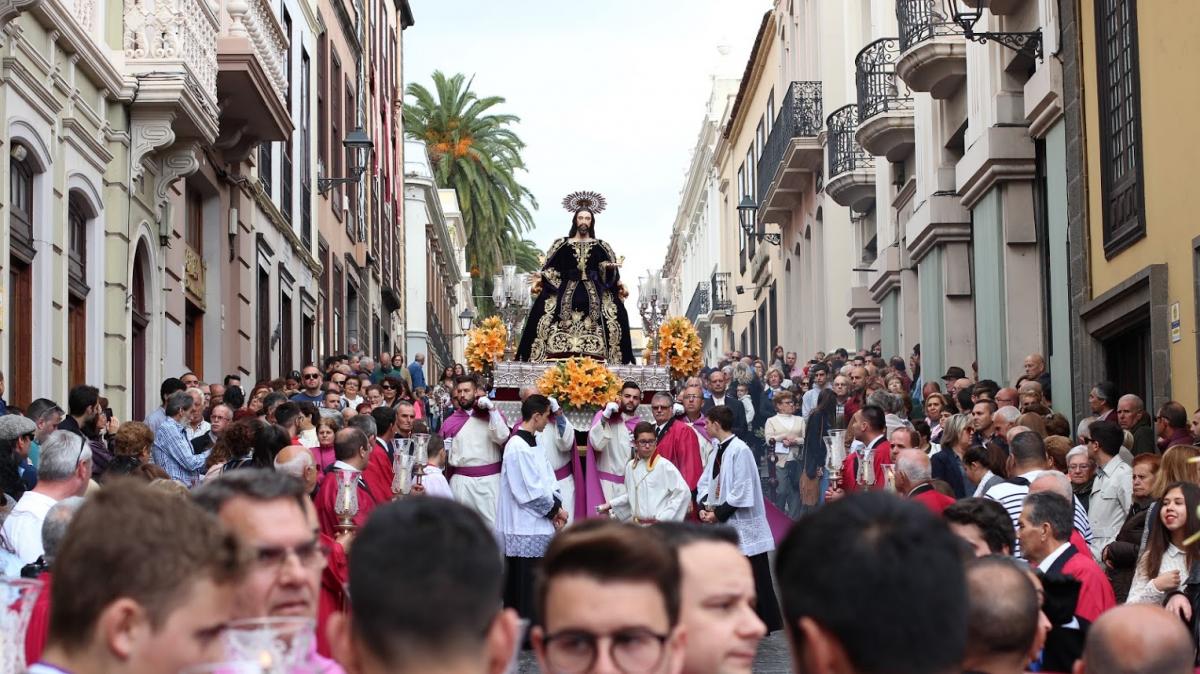
- Prayer in the Garden of Gethsemane.
At 7:00 p.m., a procession runs from the church of San Francisco to the church of La Concepción, parading the ‘Santísimo Cristo del Huerto’, a 17th-century Castilian sculpture of anonymous authorship - the three apostles are attributed to the Canarian artist Sebastián Fernández - accompanied by the image of ‘Nuestra Señora de los Dolores’, anonymous dressed image also from the seventeenth century. Both sculptures survived the fire that ravaged the Franciscan convent in 1801. After the Confiscation, the ‘Virgen de los Dolores’ image was transferred to the church of La Concepcion, until the time, in the twentieth century, when it was returned to the church of San Francisco. The ‘Dolorosa’ image was incorporated into the processional cortege of the ‘Señor del Huerto’ image in the Holy Week of 1991, by initiative of the ‘Santísimo Cristo del Huerto’ Confraternity, founded in 1984.
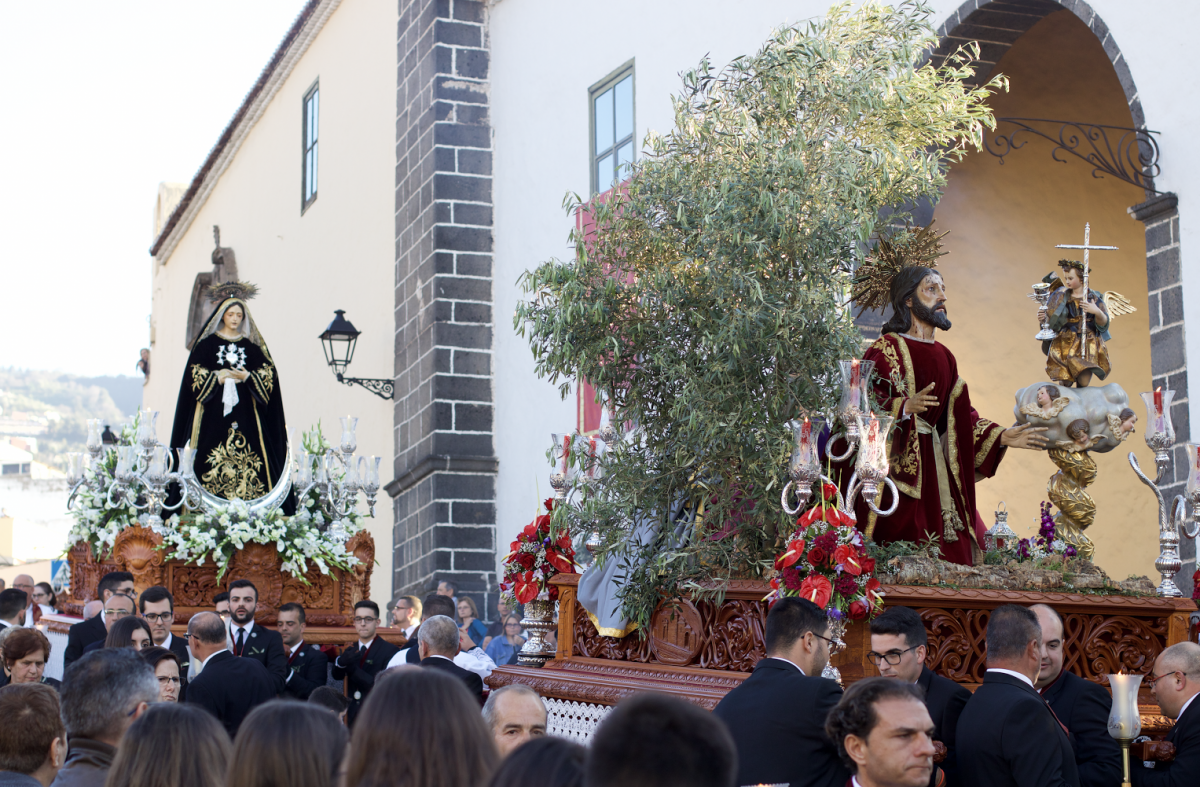
- Holy Monday.
At 9:00 pm, from the church of San Juan Bautista and through the nearest streets, the procession of Ecce Homo or ‘Señor de la Cañita takes place. It is an anonymous image from the seventeenth century, donated by Pedro Gil del Hoyo to the Augustinian convent of Nuestra Señora de Gracia, from where it was transferred to the San Juan church after the religious orders confiscation process.
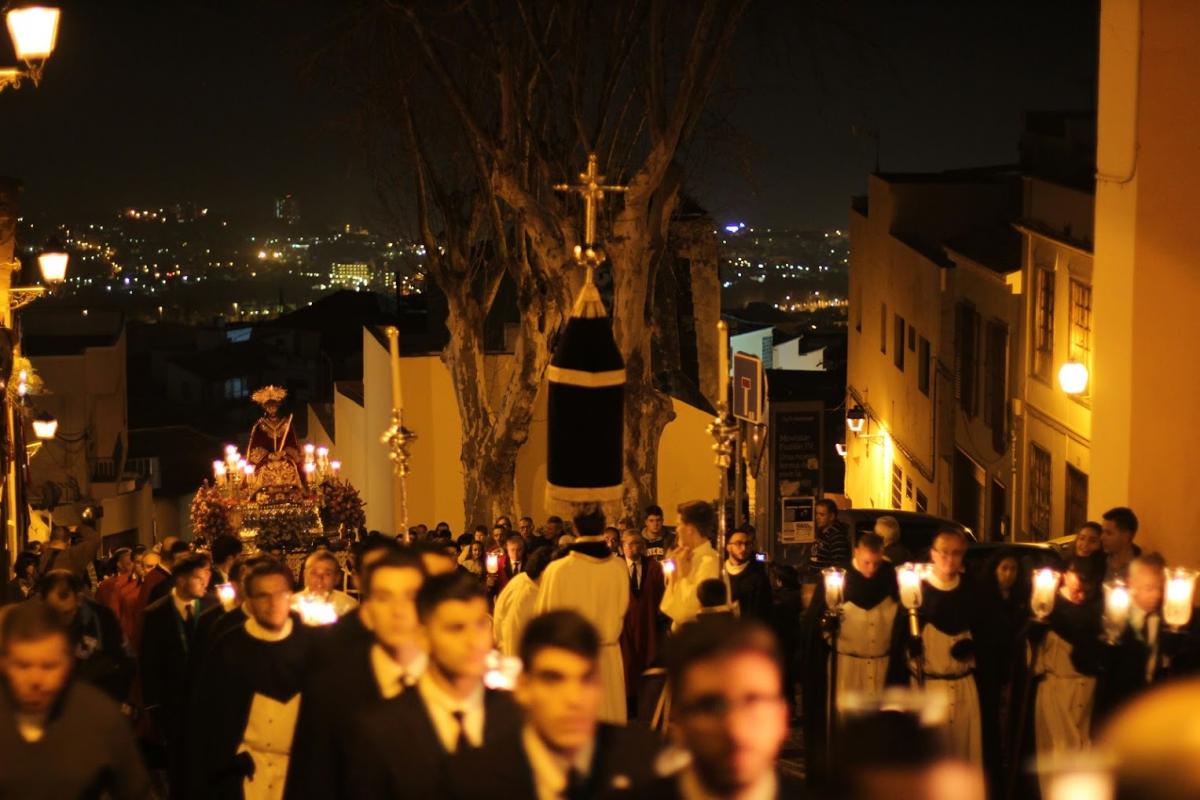
- Holy Tuesday.
At 9:00 p.m., the procession of the ‘Señor Preso’ and ‘Lágrimas de San Pedro’ images takes place in the surroundings of the Concepción parish. The first image is dated in the seventeenth century and it is attributed to Francisco Alonso de la Raya, member of the Garachico School. The ‘San Pedro Penitente’, also a dressed image, is attributed to Sebastián Fernández Méndez ‘el Viejo’.
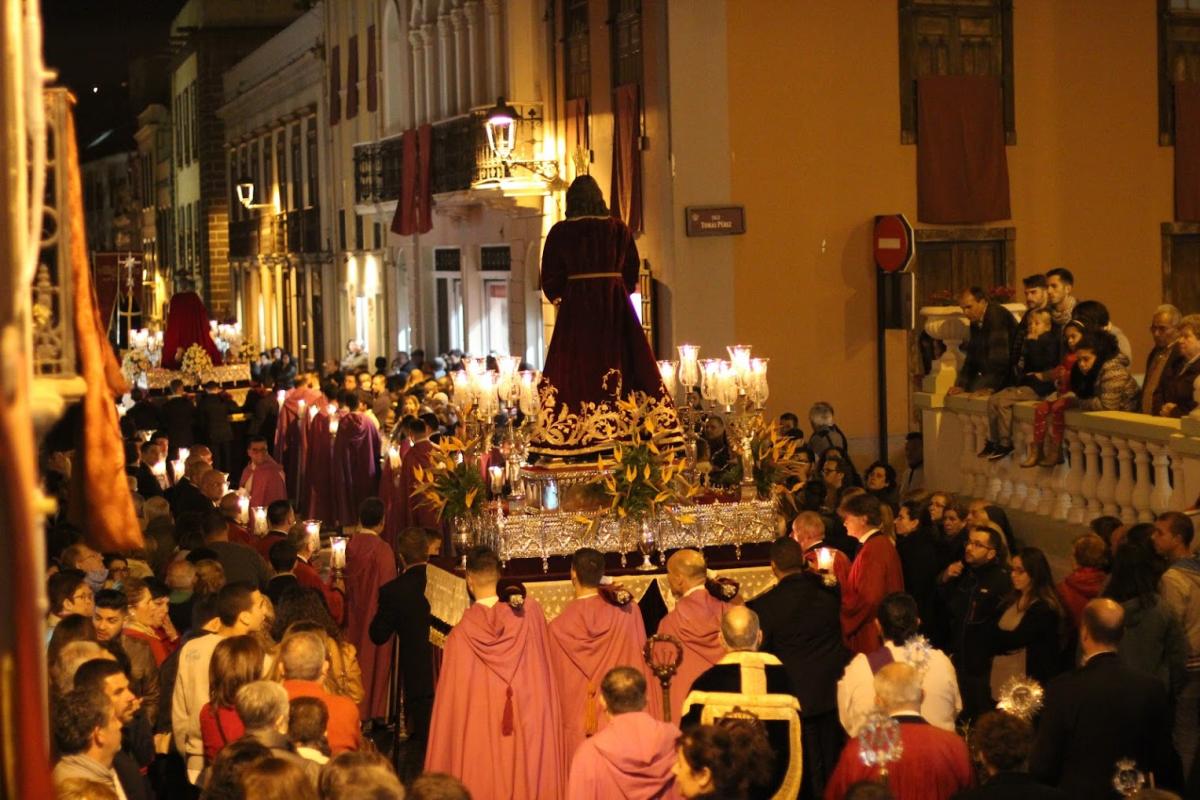
- Holy Wednesday.
At 9:00 p.m., the ‘Santísimo Cristo de la Humildad y Paciencia’ float leaves from the church of San Agustín, an anonymous polychrome wood carving of the seventeenth century attributed to the members of the Garachico school, donated to the Augustinian convent by the councilman Nicolás Ventura Valcárcel y Lugo, accompanied by the ‘Virgen de los Dolores’ of the church of San Agustín. It counts with its own confraternity in charge of its cult and procession from 1989.
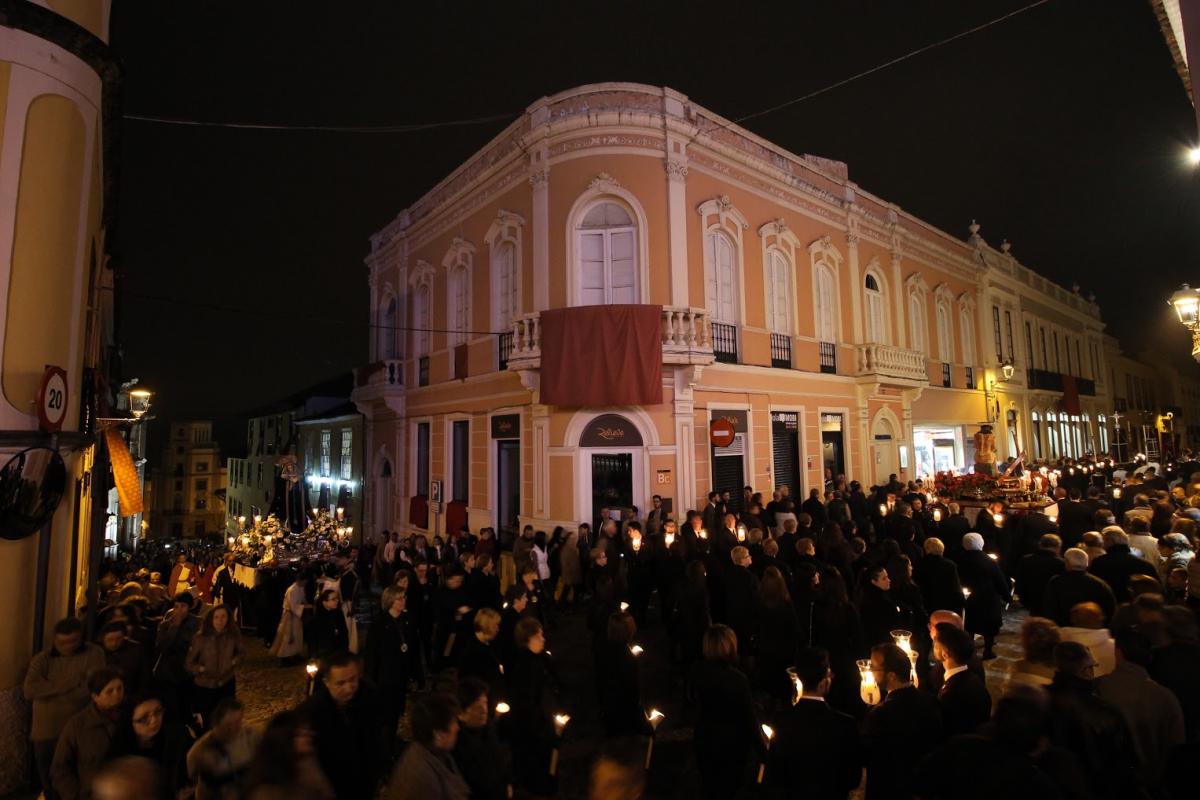
- Holy Thursday
Mandate Procession.
At 6:00 p.m., after the conclusion of the solemn celebration of the Lord's Supper, the procession of ‘El Mandato’ departs from Nuestra Señora de la Concepción Main Parish. Its processional cortege, organized by the ‘Vera Cruz’ confraternity, is composed of the following images: The first one is the ‘Magdalena Penitente’, the same one that is paraded on Palm Sunday together with the ‘Señor Predicador’ image, which was incorporated into this procession in the twentieth century; and the third one is the ‘San Juan Evangelista’ image, made in 1799 by José Luján Pérez at the request of the aforementioned ‘Vera Cruz y Misericordia’ confraternity. The most prominent image of the procession is the ‘Santísimo Cristo de la Misericordia’, a crucified Christ made in 1585 by Rui Díaz de Argumedo, an artist of Portuguese origin. The image of ‘Nuestra Señora de los Dolores’, a carved image made in 1798 by the aforementioned Luján Pérez. Its cruciform pectoral, belonging to Bishop Luis Folgueras y Sion, first bishop of the ‘Nivariense’ Diocese, stands out.
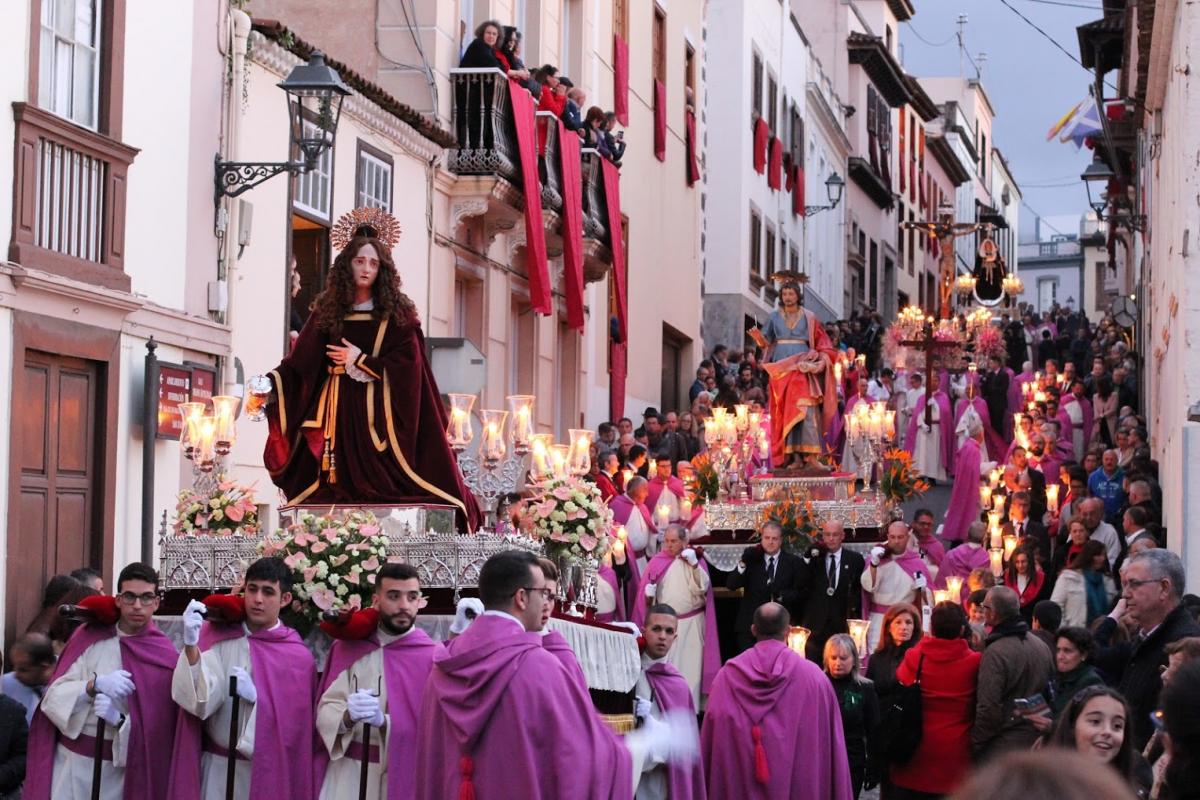
- Santísimo Cristo atado a la Columna. (Holy Christ tied to the Column).
At 10:00 p.m., the procession of the ‘Santísimo Cristo atado a la Columna” leaves the San Juan Bautista church under the organization of the ‘Esclavitud’ (Slavery) confraternity founded in 1758 as well as the ‘Damas de Gloria’ (Ladies of Glory) confraternity. The image, donated by Francisco Leonardo de Guerra in 1689, and executed by the Sevillian artist Pedro Roldán, is considered as one of the most outstanding religious sculptures of the Holy Week, not only locally or in the Canary Islands but also in the other regions of Spain. In addition to the Christ image, the processional cortege is compound of ‘María Magdalena’, dressed image made by José Luján Pérez after 1801, the ‘San Juan Bautista’, popularly known as ‘El Enamorado’ (the one in love), made by the local sculptor Fernando Estévez in the early nineteenth century, and the ‘Virgen de Gloria’, a remarkable image made by the aforementioned Luján Pérez, dated between 1799 and 1806, which is regarded as an excellent example of the glued-cloths technique. The highlight of this procession takes place when it reaches the Town Hall Square, where the ‘Adiós a la Vida’ from the opera Tosca by Giacomo Puccini, together with the light of candles, create a unique atmosphere shared by both the participants and the numerous spectators who meet there during the night of Holy Thursday. After a sermon pronounced from the central balcony, the procession parades back to the parish of El Farrobo on San Francisco Street.
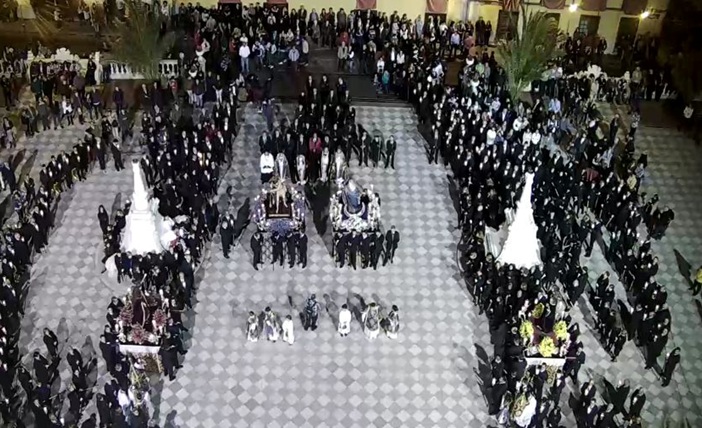
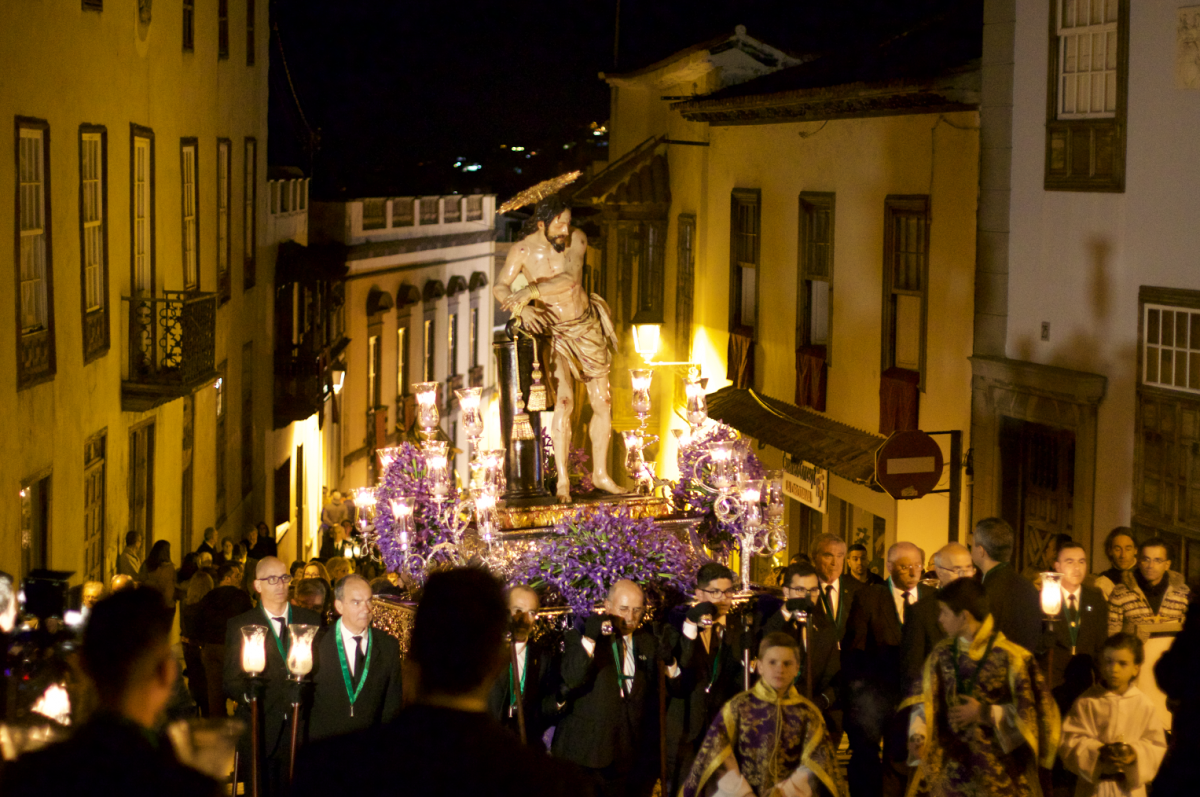
- Good Friday.
- ‘El Encuentro’ procession (Procession of the Encounter).
At 08:00 a.m., the Encounter procession leaves from the church of Santo Domingo de Guzmán and each of the different images involved takes a different route to meet again at the Patricio García square. This is a procession composed of the following images: ‘Veronica, Magdalena’ and ‘San Juan’, anonymous images made in the eighteenth century, and the image of ‘Nuestra Señora de los Dolores’ also by an unknown author. The procession is presided over by the ‘Jesús Nazareno’ image accompanied by ‘Simón Cirineo’, an 18th-century sculpture attributed to José Rodríguez de La Oliva. It is a very popular procession among the population, largely thanks to the peculiar race of the ‘San Juan’ image to meet the Virgin. After the chanting of the choir and the traditional sermon from the Post Office building, the images return together to the parish of origin.
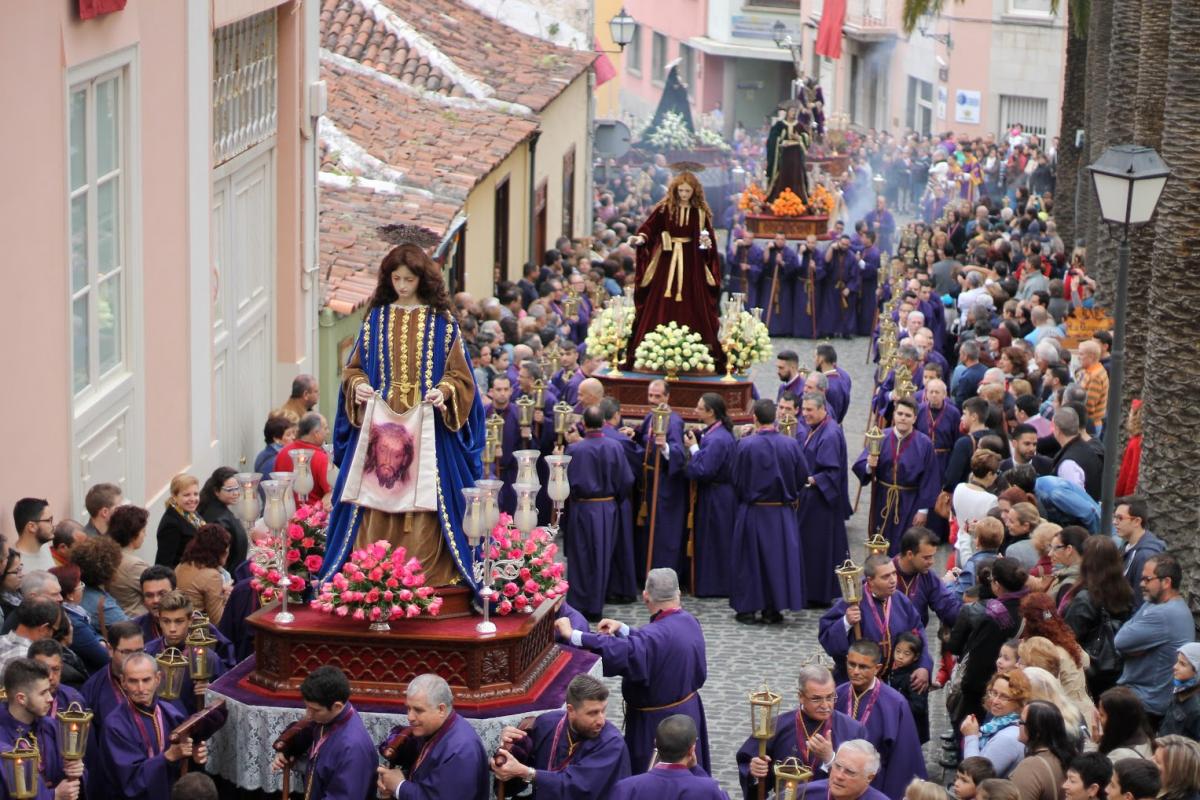
- The Calvary procession
At 12 noon, the procession of the ‘Santísimo Cristo del Calvario’ or ‘La Piedad’ sculptural group leaves from the hermitage of El Calvario - Parish of San Isidro-, and heads for the Concepción church, under the organization of the Venerable Confraternity founded in 1864. This sculptural group was made by Fernando Estévez in 1814. However, until 1861 the image was not integrated into the Holy Week in La Orotava. The cortege is made up, in addition to the above mentioned ‘Piedad’, by the following images: the so-called ‘Holy Men’, ‘Nicodemo’ and ‘José de Arimatea’, nineteenth-century sculptures attributed to Aurelio Carmona López, an artist from the island of La Palma; ‘La Magdalena’ and the ‘San Juan Evangelista’, both anonymous images from the 19th century.
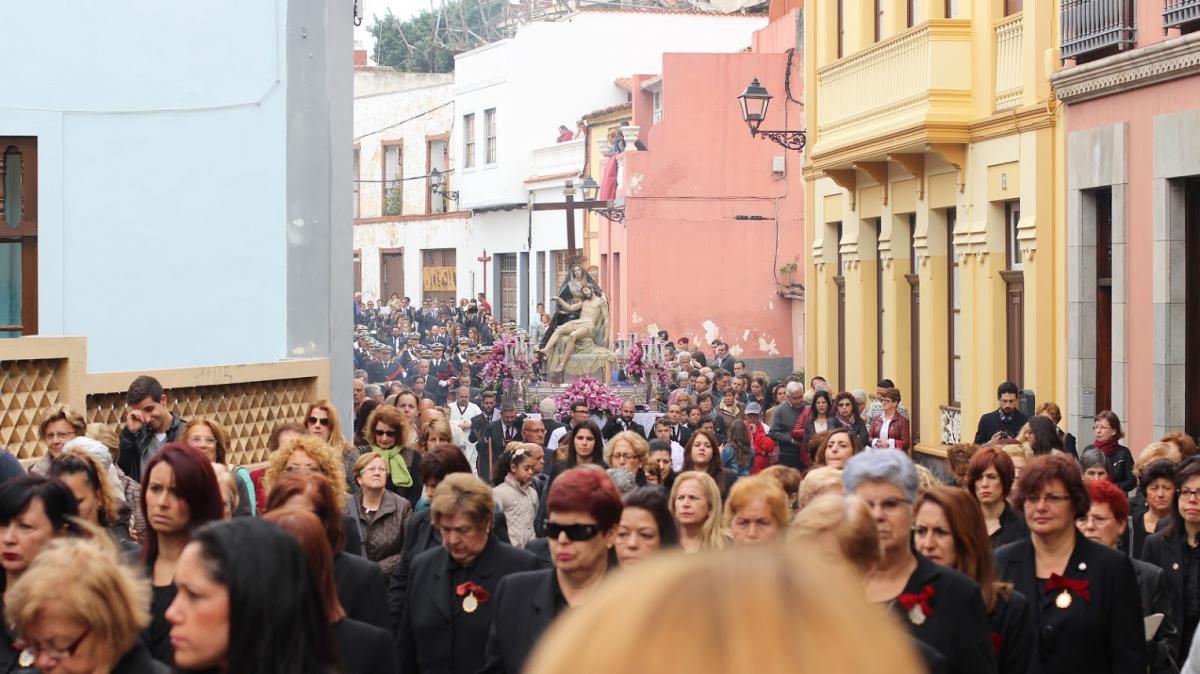
- The Holy Burial procession.
At 6:30 p.m., the ‘Santo Entierro’ (Holy Burial) procession leaves from the parish of San Juan Bautista. All the confraternities of the temple participate under the coordination of the ‘Santo Entierro’ confraternity, constituted in 1994. Until the Mendizabal Confiscation, the procession left the Franciscan convent of San Lorenzo. The processional cortege is compound of the following images: the ‘Holy Men’, ‘Nicodemo’ and ‘José de Arimatea’, anonymous sculptures from the eighteenth century; ‘María Magdalena’, executed by José Luján Pérez around 1801; The aforementioned ‘San Juan Bautista’ , ‘El Enamorado’ (The One in Love) by Fernando Estévez; And the ‘Señor Muerto’ image, an articulated crucified Christ that can be transformed into a recumbent image, made in the seventeenth century and attributed to Francisco de Ocampo. The cortege is closed by ‘La Virgen de los Dolores’ made by Fernando Estévez in 1816. The procession goes through the upper streets of the town centre, it descends to the church of San Francisco to perform the traditional visit to its former headquarters and, after passing the Town Hall Square, it ascends by León Street back to El Farrobo.
Once in the temple, the Ceremony of the Burial of Christ takes place, where the image is transferred from its silver urn, to the wood sepulchre enabled for the ritual. It should be noted that every five years, the procession is preceded by the Ceremony of the Descent, in which the Crucified Christ is descended from the cross and placed in the urn, after being shown to his Sorrowful Mother.
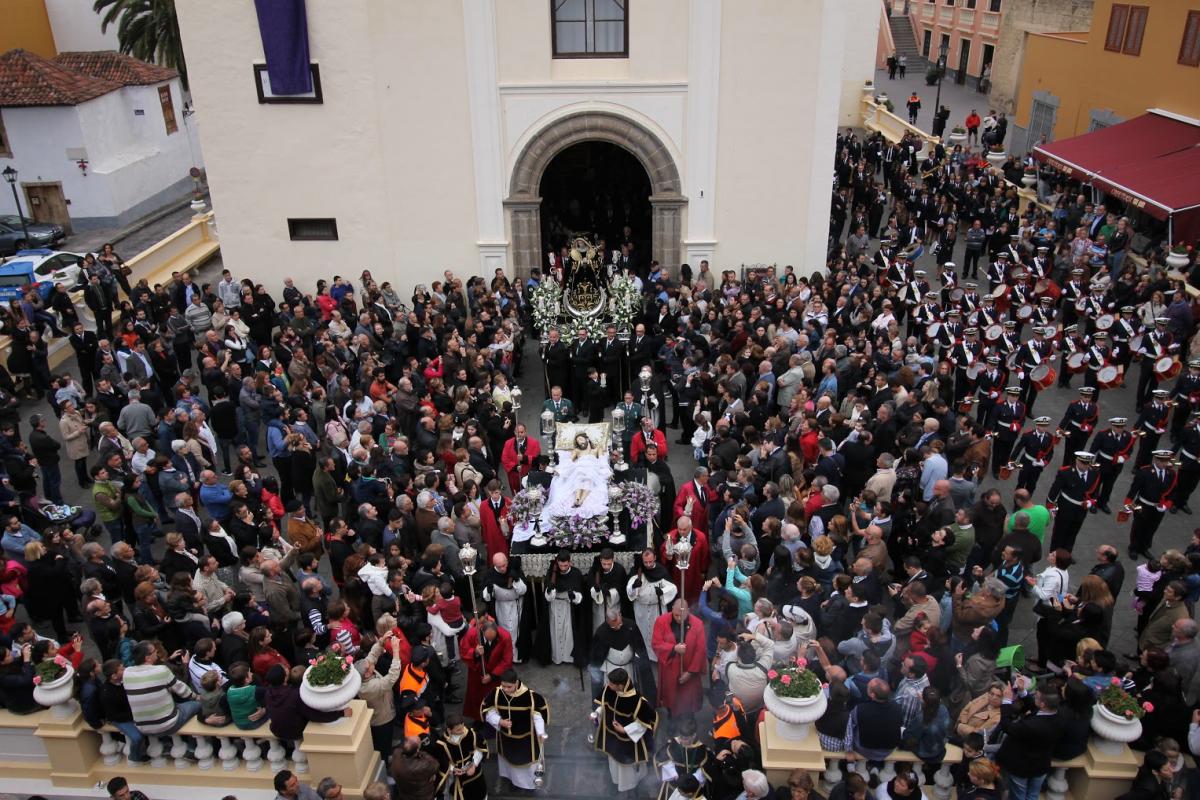
- Retreat Procession.
At 10:00 p.m., once the Burial of Christ is over, the dagger is removed from the ‘Virgen de los Dolores’ made by Fernando Estévez, and then, in silence and illuminated by candles, it ascends by the upper part of the town centre until it arrives at the Piedad hermitage.
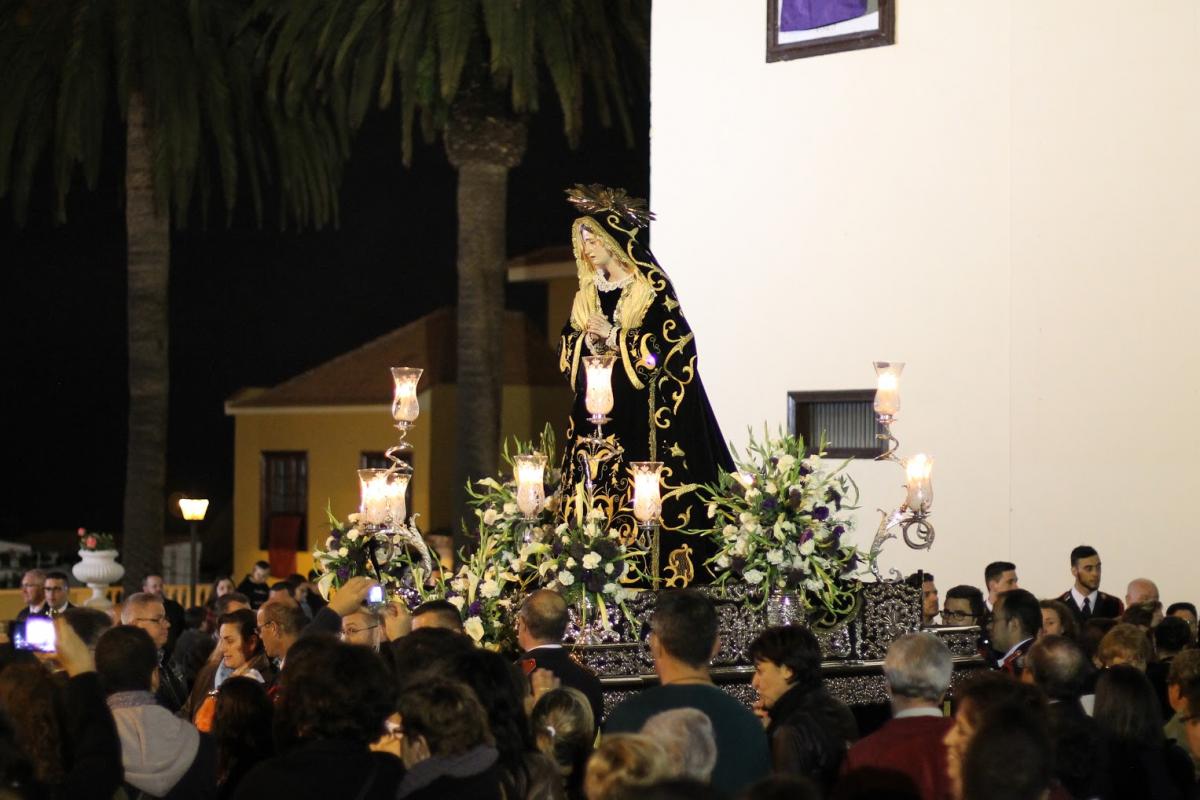
- Procession of Silence.
After 11:30 p.m., the Procession of Silence takes place in the Main Parish. Its protagonist is the ‘Dolorosa’ a Sorrowful Virgin by Luján Pérez, who also parades in the afternoon of Holy Thursday next to the ‘Cristo de la Misericordia’. The procession, organized since 1953, takes place in complete silence and in darkness, interrupted only by the light of the candles held by the participants in the procession.
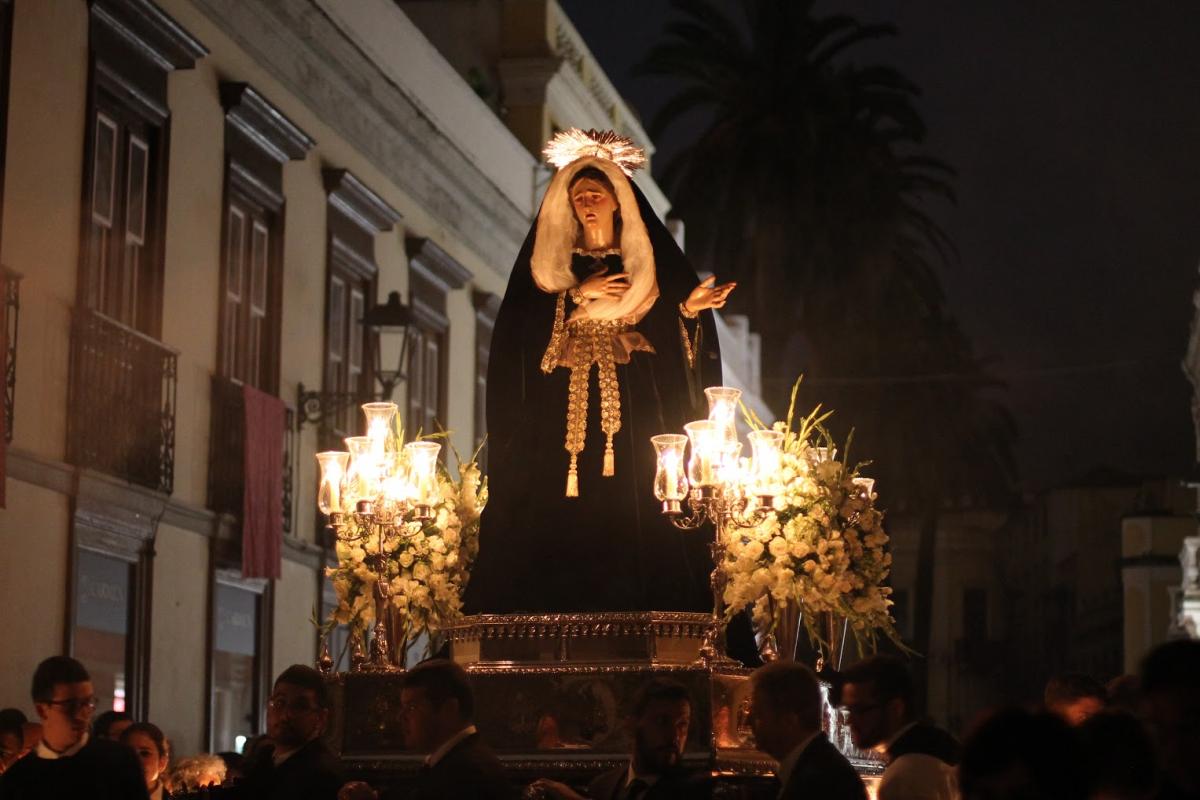
- Holy Saturday.
At 10:00 p.m., the ‘Virgen de los Dolores’ image from the church of San Juan Bautista, descends from the hermitage of La Piedad to its parish of origin, to begin the Easter Vigil, prior to the ceremony of proclamation of the Resurrection of Christ that will take place at midnight. Then the procession parades through the streets closest to the parish of El Santísimo Sacramento, which is materialized in a silver monstrance decorated with precious stones made in 1785 by Antonio Agustín Villavicencio.
- Resurrection Sunday.
- Blessed Sacrament.
At 12:30 p.m., after the celebration of the Eucharist in the Main Parish of Nuestra Señora de la Concepción, the procession of the ‘Santísimo Sacramento’ monstrance takes place through various streets of the lower part of the town centre. The notable gothic gilded monstrance, decorated with precious stones, made in 1520 in Portuguese workshops, is paraded under a canopy, with a shower of petals, the scent of incense and the ringing of bells, with the participation of all the confraternities of the parish.
- Procession of the Resurrected One.
At 7:30 p.m., the procession of ‘el Santísimo Cristo Resucitado’ leaves from the parish of Santo Domingo de Guzman. This image was made by the local artist Ezequiel de León in 1996. It parades through the streets closest to the parish. Together with the ‘Cristo de la Salud’ and the ‘Señor del Despojo’ image. It is one of the latest processions incorporated into the Holy Week in La Orotava, acting as its epilogue.
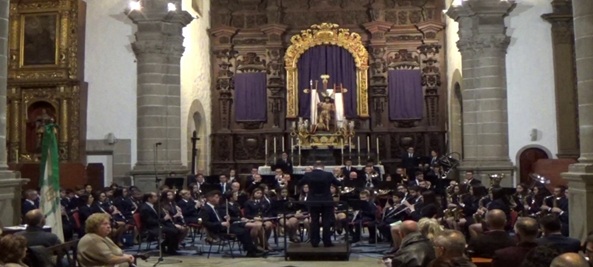
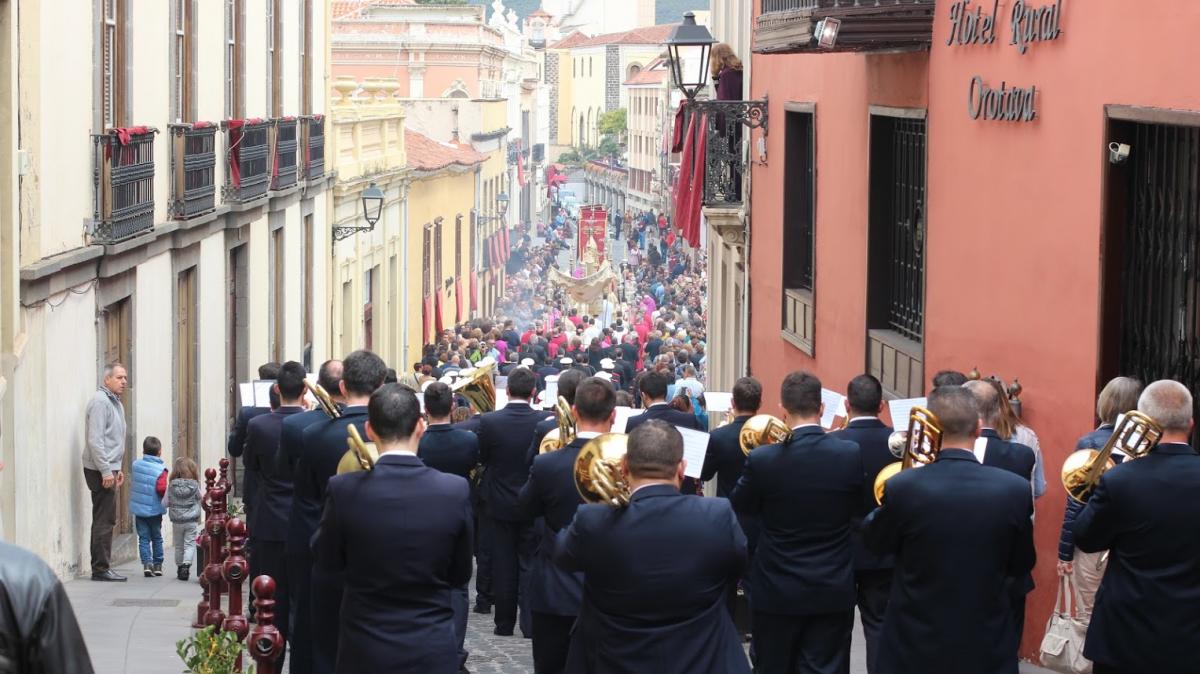
The Holy Week in La Orotava allows us to verify the traditional and religious fidelity of this town and also to witness the greatest display of baroque and neoclassical art of all the regions of Spain, where the spectator can enjoy works of art conceived for their use as means to move your soul.
Deep spiritual and religious values together with many different aspects contribute to make up a sober and aesthetically attractive Holy Week. In spite of the socio-cultural transformations, inherent in the passage of the centuries, only the precise changes in its organization have been effected, without altering the primordial essence of the ceremonial, perpetuating a patrimonial legacy thanks to the respect and dedication that receives on the part of its protagonists, the people from La Orotava, who participate as members of confraternities, devotees or simply as vital and indispensable spectators.
Despite the passage of time and the great changes experienced in society, the Holy Week in La Orotava continues to be a great event today, repeated year after year but vividly awaited by the citizens of La Orotava and by its visitors alike.
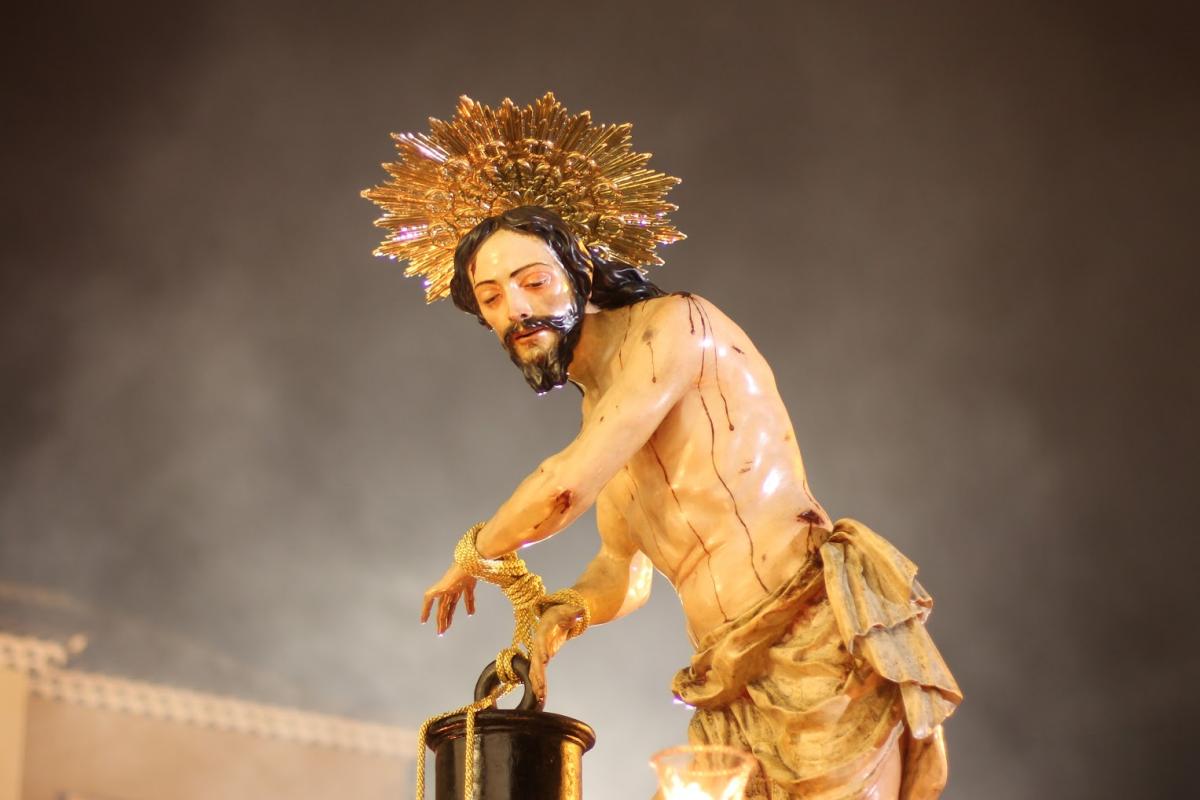
‘Santísimo Cristo atado a la Columna’ (Holy Christ tied to the Column)










